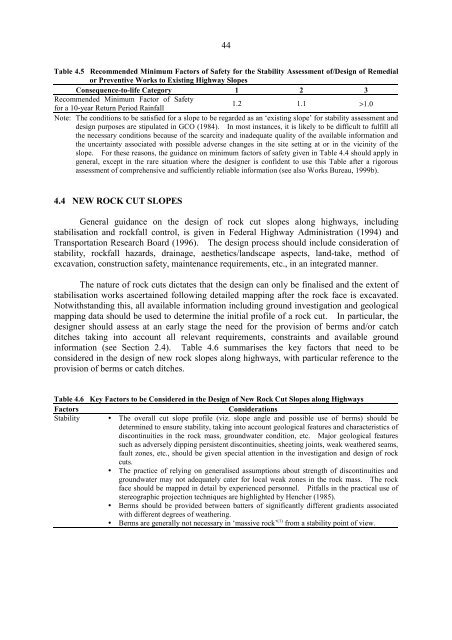Highway Slope Manual
Highway Slope Manual
Highway Slope Manual
Create successful ePaper yourself
Turn your PDF publications into a flip-book with our unique Google optimized e-Paper software.
44<br />
Table 4.5 Recommended Minimum Factors of Safety for the Stability Assessment of/Design of Remedial<br />
or Preventive Works to Existing <strong>Highway</strong> <strong>Slope</strong>s<br />
Consequence-to-life Category 1 23<br />
Recommended Minimum Factor of Safety<br />
1.2 1.1 >1.0<br />
for a 10-year Return Period Rainfall<br />
Note: The conditions to be satisfied for a slope to be regarded as an ‘existing slope' for stability assessment and<br />
design purposes are stipulated in GCO (1984). In most instances, it is likely to be difficult to fulfill all<br />
the necessary conditions because of the scarcity and inadequate quality of the available information and<br />
the uncertainty associated with possible adverse changes in the site setting at or in the vicinity of the<br />
slope. For these reasons, the guidance on minimum factors of safety given in Table 4.4 should apply in<br />
general, except in the rare situation where the designer is confident to use this Table after a rigorous<br />
assessment of comprehensive and sufficiently reliable information (see also Works Bureau, 1999b).<br />
4.4 NEW ROCK CUT SLOPES<br />
General guidance on the design of rock cut slopes along highways, including<br />
stabilisation and rockfall control, is given in Federal <strong>Highway</strong> Administration (1994) and<br />
Transportation Research Board (1996). The design process should include consideration of<br />
stability, rockfall hazards, drainage, aesthetics/landscape aspects, landtake, method of<br />
excavation, construction safety, maintenance requirements, etc., in an integrated manner.<br />
The nature of rock cuts dictates that the design can only be finalised and the extent of<br />
stabilisation works ascertained following detailed mapping after the rock face is excavated.<br />
Notwithstanding this, all available information including ground investigation and geological<br />
mapping data should be used to determine the initial profile of a rock cut. In particular, the<br />
designer should assess at an early stage the need for the provision of berms and/or catch<br />
ditches taking into account all relevant requirements, constraints and available ground<br />
information (see Section 2.4). Table 4.6 summarises the key factors that need to be<br />
considered in the design of new rock slopes along highways, with particular reference to the<br />
provision of berms or catch ditches.<br />
Table 4.6 Key Factors to be Considered in the Design of New Rock Cut <strong>Slope</strong>s along <strong>Highway</strong>s<br />
Factors<br />
Considerations<br />
Stability • The overall cut slope profile (viz. slope angle and possible use of berms) should be<br />
determined to ensure stability, taking into account geological features and characteristics of<br />
discontinuities in the rock mass, groundwater condition, etc. Major geological features<br />
such as adversely dipping persistent discontinuities, sheeting joints, weak weathered seams,<br />
fault zones, etc., should be given special attention in the investigation and design of rock<br />
cuts.<br />
• The practice of relying on generalised assumptions about strength of discontinuities and<br />
groundwater may not adequately cater for local weak zones in the rock mass. The rock<br />
face should be mapped in detail by experienced personnel. Pitfalls in the practical use of<br />
stereographic projection techniques are highlighted by Hencher (1985).<br />
• Berms should be provided between batters of significantly different gradients associated<br />
with different degrees of weathering.<br />
• Berms are generally not necessary in ‘massive rock' (1) from a stability point of view.

















